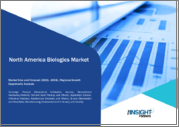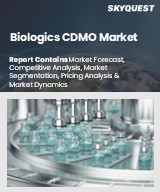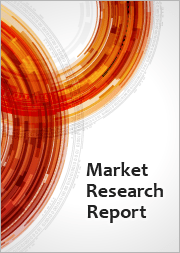
|
시장보고서
상품코드
1764936
북미의 생물 제제 시장 : 예측 - 지역별 분석 - 제품, 용도, 공급원, 제조별North America Biologics Market Forecast to 2031 - Regional Analysis - by Product, Application, Source, and Manufacturing |
||||||
북미의 생물 제제 시장은 2023년에 2,302억 5,610만 달러로 평가되었고, 2031년에는 8,888억 8,000만 달러에 이를 것으로 예측되며, 2023-2031년의 CAGR은 18.4%를 나타낼 전망입니다.
만성 질환 증가는 북미의 생물 제제 시장을 활성화
Ellerston Capital Limited에 게재된 '만성 질환 : 생물학적 접근(Chronic Disease: A Bio-Logical Approach)' 이라는 연구에 따르면 세계에서 매년 4,100만 명이 만성질환으로 사망하고 있으며 전 세계 사망자 수의 74%를 차지하고 있습니다. 암은 2020년에 약 천만 명의 사망자, 즉 6명 중 1명의 사망자를 발생시켰습니다. 또한, 자가면역 질환의 유병률은 매년 3-9%씩 증가하고 있습니다. 안타깝게도 알츠하이머병 환자 수는 2030년까지 7,800만 명, 2050년까지 1억 3,900만 명에 이를 것으로 예상됩니다. 세계보건기구(WHO)에 따르면 매년 세계 1,700만 명이 70세까지 비전염성 질환으로 생명을 잃고 있습니다.
항체나 백신 등의 생물제제는 치료나 예방효과를 가져오기 위해 면역계와 특이적으로 상호작용하도록 설계되어 있기 때문에 보다 적당한 치료가 가능합니다. 생물 제제는 관절, 피부 및 기타 신체 부위를 손상시키는 면역 체계의 과도한 구성 요소를 차단하여 몇 가지 만성 자가면역 질환을 치료할 수 있는 유망한 잠재력을 가지고 있습니다. 생물제제를 이용한 암의 치료에서는 체내의 면역세포를 이용해 암세포를 사멸시키고 있습니다. 궤양성 대장염과 크론병 등의 만성 질환에서는 대장 점막의 염증이 반복적으로 일어납니다. 여기에는 인플릭시맙, 아달리무맙, 나탈리주맙이 포함됩니다. 의사와 환자의 기호가 전통적인 접근에서 적극적인 접근으로 변화함에 따라 류마티스 관절염의 생물 제제에 대한 수요도 증가하는 경향이 있습니다.
북미의 생물 제제 시장 개요
북미는 생물 제제 시장의 매출에서 가장 큰 점유율을 차지합니다. JAMA Network에 게재된 기사에 따르면, 생물 제제의 연구개발비는 미국의 연구개발비 전체의 37%를 차지하고 있습니다. 미국에서는 생물 제제의 배합 수가 증가하고 표적 약물 개발에 대한 투자도 증가하고 있습니다. 게다가, 안티센스, 유전자 요법, RNAi 요법 등 몇 가지 새로운 생물학적 약제의 승인이 시장 성장을 더욱 촉진할 것으로 예측됩니다. 미국 국립생물공학정보센터(NCBI)가 발표한 기사에 따르면 2022년 생물제제의 승인률은 40%로 역사적으로 최고를 기록했으며, 이는 의약품 용도에서 생물 제제의 안정성을 보여줍니다. 게다가 이 카테고리의 의약품은 전체 의약품 승인의 30%를 차지합니다. 2024년 5월, Biocon Biologics Ltd(BBL)는 Eylea를 대체하는 최초의 생물 제제로 YESAFILI(aflibercept)의 FDA 승인을 받았습니다. YESAFILI는 혈관 내피 성장 인자(VEGF) 억제제이며 다양한 안과 질환의 치료에 사용됩니다.
북미의 생물 제제 시장의 수익과 2031년까지의 예측(금액)
북미 생물 제제 시장의 세분화
북미의 생물 제제 시장은 제품, 용도, 공급원, 제조, 국가로 분류됩니다.
제품별로 북미의 생물제제 시장은 단일클론항체, 백신, 유전자 재조합 호르몬/단백질, 세포 및 유전자 치료 등으로 구분됩니다. 단클론 항체 부문은 2023년에 가장 큰 시장 점유율을 차지했습니다.
용도별로 북미의 생물제제 시장은 암, 감염증, 자가면역질환 등으로 분류됩니다. 2023년에는 암 부문이 가장 큰 시장 점유율을 차지했습니다.
공급원별로 북미의 생물 제제 시장은 포유류와 미생물로 이분됩니다. 2023년에는 포유류 부문이 더 큰 시장 점유율을 차지했습니다.
제조별로 북미의 생물 제제 시장은 외주와 자사로 이분됩니다.
국가별로 북미의 생물 제제 시장은 미국, 캐나다, 멕시코로 구분됩니다.
AbbVie Inc, Pfizer Inc, Samsung Biologics Co Ltd, ADMA Biologics, Inc, Wuxi Biologics Inc, Catalent Inc, AGC Biologics AS, AstraZeneca Plc, Amgen Inc, Nitto Avecia, Quality Assistance sa는 북미 생물 제제 시장에서 사업을 전개하는 주요 기업입니다.
목차
제1장 서론
제2장 주요 요약
- 주요 인사이트
- 시장의 매력
제3장 조사 방법
- 2차 조사
- 1차 조사
- 가설의 책정
- 거시경제 요인분석
- 파운데이션 수치의 개발
- 데이터의 삼각측량
- 국가 레벨 데이터
제4장 북미의 생물 제제 시장 : 주요 시장 역학
- 시장 성장 촉진요인
- 만성 질환 증가
- 제조업무의 아웃소싱 지향
- 시장 성장 억제요인
- 생물 제제의 고비용
- 시장 기회
- 생물 제제에 있어서의 유전자 및 세포 치료의 진보
- 향후의 동향
- 기업의 전략적 이니셔티브
- 성장 촉진요인과 억제요인의 영향
제5장 생물 제제 시장 : 북미 분석
- 북미의 생물 제제 시장의 매출액, 2021-2031년
- 북미의 생물제제 시장 예측 분석
제6장 북미의 생물제제 시장 분석 - 제품별
- 단일클론항체
- 백신
- 재조합 호르몬/단백질
- 세포 및 유전자 치료
- 기타
제7장 북미의 생물제제 시장 분석 - 용도별
- 암
- 감염증
- 자가면역질환
- 기타
제8장 북미의 생물제제 시장 분석 - 공급원별
- 포유류
- 미생물
제9장 북미의 생물제제 시장 분석 - 제조별
- 외부 위탁
- 자사 제조
제10장 북미의 생물제제 시장 - 국가별 분석
- 북미
- 미국
- 캐나다
- 멕시코
제11장 산업 정세
- 소개
- 시장 이니셔티브
- 파트너십 및 협업
- 기타 개발
제12장 기업 프로파일
- AbbVie Inc
- Pfizer Inc
- Samsung Biologics Co Ltd
- ADMA Biologics, Inc.
- WuXi Biologics Inc
- Catalent Inc
- AGC Biologics AS
- AstraZeneca Plc
- Amgen Inc
- Nitto Avecia
- Quality Assistance sa
제13장 부록
SHW 25.07.14The North America biologics market was valued at US$ 230,256.1 million in 2023 and is expected to reach US$ 888,880.0 million by 2031; it is estimated to register a CAGR of 18.4% from 2023 to 2031.
Increasing Prevalence of Chronic Diseases Fuels North America Biologics Market
According to a study titled "Chronic Disease: A Bio-Logical Approach," published in Ellerston Capital Limited, 41 million people worldwide die from chronic diseases every year, accounting for 74% of all deaths worldwide. Cancer was responsible for almost 10 million deaths in 2020, i.e., 1 in every 6 deaths. According to GLOBOCAN, 19.3 million cancer cases were registered worldwide in 2020, and the number is estimated to rise to 24.6 million by 2030. In addition, the prevalence of autoimmune diseases increases annually by 3-9%. The number of Alzheimer's disease cases is expected to reach 78 million by 2030 and 139 million by 2050. According to the World Health Organization (WHO), every year, ~17 million people across the world succumb to death due to noncommunicable diseases before the age of 70.
Biologics such as antibodies and vaccines offer more targeted treatment because they are designed to interact with the immune system in specific ways to deliver a therapeutic or prophylactic effect. Biological drugs have the promising potential to treat a few chronic autoimmune diseases by blocking the overactive components (proteins in many cases) of the immune system, which damage joints, skin, and other body parts. The treatment of cancer with biologics involves using the body's immune cells to kill cancerous cells; cytokines such as interferons, interleukins, and monoclonal antibodies (mAbs) are the most commonly used biologic therapies employed to treat cancer. Anti-amyloid mAbs have also shown promising therapeutic effects in clinical studies conducted on Alzheimer's disease patients. Chronic diseases such as ulcerative colitis and Crohn's disease include recurring episodes of inflammation of the mucosal layer of the colon. The US Food and Drug Administration has approved a few biological drugs for the treatment of Crohn's disease; these include infliximab, adalimumab, and natalizumab. Further, biological disease-modifying antirheumatic drugs are one of the major approaches to treating rheumatoid arthritis. With the shift in doctors' and patients' preference from conventional to aggressive approaches, the demand for biologics in the treatment of rheumatoid arthritis is also on the rise. Therapeutics use are partially or fully humanized proteins targeting different immune response pathways. Therefore, the increasing prevalence of chronic diseases drives the growth of the biologics market.
North America Biologics Market Overview
North America holds the largest share of the biologics market in terms of revenue. Market growth in this region is attributed to the presence of key biologics manufacturing players and the increasing spending on R and D. According to an article published in the JAMA Network, biologics R and D spending accounted for 37% of total R and D spending in the US. The number of prescriptions written for biologics and investments in the development of targeted drugs are on the rise in the country. Additionally, the approval of several novel biological drugs such as antisense, gene therapy, and RNAi therapeutics is expected to further drive the market growth. As per an article published by the National Center for Biotechnology Information (NCBI), the country recorded historically the highest percentage of biologics approvals in 2022, i.e., 40%, which indicates the stability of biologics in pharmaceutical applications. Moreover, this category of drugs accounts for 30% of the total drug approvals. In May 2024, Biocon Biologics Ltd (BBL) received FDA approval for YESAFILI (aflibercept) as the first biological alternative to Eylea. YESAFILI is a vascular endothelial growth factor (VEGF) inhibitor used to treat several different types of ophthalmology conditions.
North America Biologics Market Revenue and Forecast to 2031 (US$ Million)
North America Biologics Market Segmentation
The North America biologics market is categorized into product, application, source, manufacturing, and country.
Based on product, the North America biologics market is segmented into monoclonal antibodies, vaccine, recombinant hormones/proteins, cell and gene therapy, and others. The monoclonal antibodies segment held the largest market share in 2023.
In terms of application, the North America biologics market is categorized into cancer, infectious diseases, autoimmune diseases, and others. The cancer segment held the largest market share in 2023.
By source, the North America biologics market is bifurcated into mammalian and microbial. The mammalian segment held a larger market share in 2023.
Based on manufacturing, the North America biologics market is bifurcated into outsourced and in-house. The outsourced segment held a larger market share in 2023.
In terms of country, the North America biologics market is segmented into the US, Canada, and Mexico. The US dominated the North America biologics market share in 2023.
AbbVie Inc, Pfizer Inc, Samsung Biologics Co Ltd, ADMA Biologics, Inc., Wuxi Biologics Inc, Catalent Inc, AGC Biologics AS, AstraZeneca Plc, Amgen Inc, Nitto Avecia, and Quality Assistance s.a. are some of the leading companies operating in the North America biologics market.
Table Of Contents
1. Introduction
- 1.1 Report Guidance
- 1.2 Market Segmentation
2. Executive Summary
- 2.1 Key Insights
- 2.2 Market Attractiveness
3. Research Methodology
- 3.1 Secondary Research
- 3.2 Primary Research
- 3.2.1 Hypothesis formulation:
- 3.2.2 Macroeconomic factor analysis:
- 3.2.3 Developing base number:
- 3.2.4 Data Triangulation:
- 3.2.5 Country-level data:
4. North America Biologics Market - Key Market Dynamics
- 4.1 Market Drivers
- 4.1.1 Increasing Prevalence of Chronic Diseases
- 4.1.2 Preference for Outsourcing Manufacturing Operations
- 4.2 Market Restraints
- 4.2.1 High Cost of Biologics
- 4.3 Market Opportunities
- 4.3.1 Gene and Cell Therapy Advancements in Biologics
- 4.4 Future Trends
- 4.4.1 Strategic Initiatives by Companies
- 4.5 Impact of Drivers and Restraints:
5. Biologics Market - North America Analysis
- 5.1 North America Biologics Market Revenue (US$ Million), 2021-2031
- 5.2 North America Biologics Market Forecast Analysis
6. North America Biologics Market Analysis - by Product
- 6.1 Monoclonal Antibodies
- 6.1.1 Overview
- 6.1.2 Monoclonal Antibodies: North America Biologics Market - Revenue and Forecast, 2021-2031 (US$ Million)
- 6.2 Vaccine
- 6.2.1 Overview
- 6.2.2 Vaccine: North America Biologics Market - Revenue and Forecast, 2021-2031 (US$ Million)
- 6.3 Recombinant Hormones/Proteins
- 6.3.1 Overview
- 6.3.2 Recombinant Hormones/Proteins: North America Biologics Market - Revenue and Forecast, 2021-2031 (US$ Million)
- 6.4 Cell and Gene Therapy
- 6.4.1 Overview
- 6.4.2 Cell and Gene Therapy: North America Biologics Market - Revenue and Forecast, 2021-2031 (US$ Million)
- 6.5 Others
- 6.5.1 Overview
- 6.5.2 Others: North America Biologics Market - Revenue and Forecast, 2021-2031 (US$ Million)
7. North America Biologics Market Analysis - by Application
- 7.1 Cancer
- 7.1.1 Overview
- 7.1.2 Cancer: North America Biologics Market - Revenue and Forecast, 2021-2031 (US$ Million)
- 7.2 Infectious Diseases
- 7.2.1 Overview
- 7.2.2 Infectious Diseases: North America Biologics Market - Revenue and Forecast, 2021-2031 (US$ Million)
- 7.3 Autoimmune Diseases
- 7.3.1 Overview
- 7.3.2 Autoimmune Diseases: North America Biologics Market - Revenue and Forecast, 2021-2031 (US$ Million)
- 7.4 Others
- 7.4.1 Overview
- 7.4.2 Others: North America Biologics Market - Revenue and Forecast, 2021-2031 (US$ Million)
8. North America Biologics Market Analysis - by Source
- 8.1 Mammalian
- 8.1.1 Overview
- 8.1.2 Mammalian: North America Biologics Market - Revenue and Forecast, 2021-2031 (US$ Million)
- 8.2 Microbial
- 8.2.1 Overview
- 8.2.2 Microbial: North America Biologics Market - Revenue and Forecast, 2021-2031 (US$ Million)
9. North America Biologics Market Analysis - by Manufacturing
- 9.1 Outsourced
- 9.1.1 Overview
- 9.1.2 Outsourced: North America Biologics Market - Revenue and Forecast, 2021-2031 (US$ Million)
- 9.2 In-house
- 9.2.1 Overview
- 9.2.2 In-house: North America Biologics Market - Revenue and Forecast, 2021-2031 (US$ Million)
10. North America Biologics Market - Country Analysis
- 10.1 North America
- 10.1.1 North America Biologics Market - Revenue and Forecast Analysis - by Country
- 10.1.1.1 North America Biologics Market - Revenue and Forecast Analysis - by Country
- 10.1.1.2 United States: North America Biologics Market - Revenue and Forecast, 2021-2031 (US$ Million)
- 10.1.1.2.1 United States: North America Biologics Market Share - by Product
- 10.1.1.2.2 United States: North America Biologics Market Share - by Application
- 10.1.1.2.3 United States: North America Biologics Market Share - by Source
- 10.1.1.2.4 United States: North America Biologics Market Share - by Manufacturing
- 10.1.1.3 Canada: North America Biologics Market - Revenue and Forecast, 2021-2031 (US$ Million)
- 10.1.1.3.1 Canada: North America Biologics Market Share - by Product
- 10.1.1.3.2 Canada: North America Biologics Market Share - by Application
- 10.1.1.3.3 Canada: North America Biologics Market Share - by Source
- 10.1.1.3.4 Canada: North America Biologics Market Share - by Manufacturing
- 10.1.1.4 Mexico: North America Biologics Market - Revenue and Forecast, 2021-2031 (US$ Million)
- 10.1.1.4.1 Mexico: North America Biologics Market Share - by Product
- 10.1.1.4.2 Mexico: North America Biologics Market Share - by Application
- 10.1.1.4.3 Mexico: North America Biologics Market Share - by Source
- 10.1.1.4.4 Mexico: North America Biologics Market Share - by Manufacturing
- 10.1.1 North America Biologics Market - Revenue and Forecast Analysis - by Country
11. Industry Landscape
- 11.1 Overview
- 11.2 Market Initiative
- 11.3 Partnerships and Collaborations
- 11.4 Other Developments
12. Company Profiles
- 12.1 AbbVie Inc
- 12.1.1 Key Facts
- 12.1.2 Business Description
- 12.1.3 Products and Services
- 12.1.4 Financial Overview
- 12.1.5 SWOT Analysis
- 12.1.6 Key Developments
- 12.2 Pfizer Inc
- 12.2.1 Key Facts
- 12.2.2 Business Description
- 12.2.3 Products and Services
- 12.2.4 Financial Overview
- 12.2.5 SWOT Analysis
- 12.2.6 Key Developments
- 12.3 Samsung Biologics Co Ltd
- 12.3.1 Key Facts
- 12.3.2 Business Description
- 12.3.3 Products and Services
- 12.3.4 Financial Overview
- 12.3.5 SWOT Analysis
- 12.3.6 Key Developments
- 12.4 ADMA Biologics, Inc.
- 12.4.1 Key Facts
- 12.4.2 Business Description
- 12.4.3 Products and Services
- 12.4.4 Financial Overview
- 12.4.5 SWOT Analysis
- 12.4.6 Key Developments
- 12.5 WuXi Biologics Inc
- 12.5.1 Key Facts
- 12.5.2 Business Description
- 12.5.3 Products and Services
- 12.5.4 Financial Overview
- 12.5.5 SWOT Analysis
- 12.5.6 Key Developments
- 12.6 Catalent Inc
- 12.6.1 Key Facts
- 12.6.2 Business Description
- 12.6.3 Products and Services
- 12.6.4 Financial Overview
- 12.6.5 SWOT Analysis
- 12.6.6 Key Developments
- 12.7 AGC Biologics AS
- 12.7.1 Key Facts
- 12.7.2 Business Description
- 12.7.3 Products and Services
- 12.7.4 Financial Overview
- 12.7.5 SWOT Analysis
- 12.7.6 Key Developments
- 12.8 AstraZeneca Plc
- 12.8.1 Key Facts
- 12.8.2 Business Description
- 12.8.3 Products and Services
- 12.8.4 Financial Overview
- 12.8.5 SWOT Analysis
- 12.8.6 Key Developments
- 12.9 Amgen Inc
- 12.9.1 Key Facts
- 12.9.2 Business Description
- 12.9.3 Products and Services
- 12.9.4 Financial Overview
- 12.9.5 SWOT Analysis
- 12.9.6 Key Developments
- 12.10 Nitto Avecia
- 12.10.1 Key Facts
- 12.10.2 Business Description
- 12.10.3 Products and Services
- 12.10.4 Financial Overview
- 12.10.5 SWOT Analysis
- 12.10.6 Key Developments
- 12.11 Quality Assistance s.a.
- 12.11.1 Key Facts
- 12.11.2 Business Description
- 12.11.3 Products and Services
- 12.11.4 Financial Overview
- 12.11.5 SWOT Analysis
- 12.11.6 Key Developments
13. Appendix
- 13.1 About Us



















